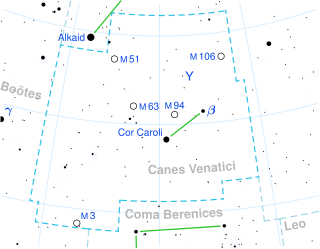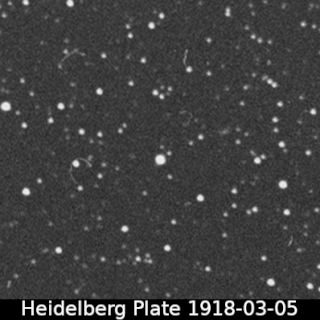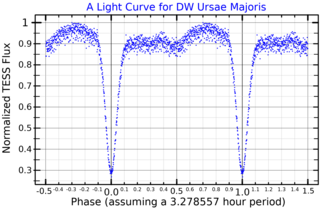
EF Eridani is a variable star of the type known as polars, AM Herculis stars, or magnetic cataclysmic variable stars. Historically it has varied between apparent magnitudes 14.5 and 17.3, although since 1995 it has generally remained at the lower limit. The star system consists of a white dwarf with a substellar-mass former star in orbit.

La Superba is a strikingly red giant star in the constellation Canes Venatici. It is a carbon star and semiregular variable.

C1 Centauri is a single star in the southern constellation of Centaurus. It has the variable star designation V763 Centauri, while C1 Centauri is the Bayer designation. The star has a red hue and is dimly visibly to the naked eye with an apparent visual magnitude that fluctuates around +5.64. It is located at a distance of approximately 600 light years based on parallax, and has an absolute magnitude of −1.05. It is drifting further away with a radial velocity of +21 km/s. At one time it was a candidate member of the Zeta Herculis Moving Group but has since been excluded.

HD 125823, also known as V761 Centauri or a Centauri, is a variable star in the constellation Centaurus. It is a blue-white star that is visible to the naked eye with a mean apparent visual magnitude of +4.41. The distance to this star is approximately 460 light years based on parallax measurements. It is a member of the Upper Centaurus–Lupus subgroup of the Scorpius–Centaurus association.

R Centauri is a Mira variable star in the constellation Centaurus.
An AM Canum Venaticorum star, is a rare type of cataclysmic variable star named after their type star, AM Canum Venaticorum. In these hot blue binary variables, a white dwarf accretes hydrogen-poor matter from a compact companion star.
AM Canum Venaticorum is a hydrogen-deficient cataclysmic variable binary star in the constellation of Canes Venatici. It is the type star of its class of variables, the AM Canum Venaticorum stars. The system consists of a white dwarf gaining matter via an accretion disk from a semi-degenerate or white dwarf companion.

RX Andromedae is a variable star in the constellation of Andromeda. Although it is classified as a dwarf nova of the Z Camelopardalis (UGZ) type, it has shown low-luminosity periods typical of VY Sculptoris stars. However, for most of the time it varies from an apparent visual magnitude of 15.1 at minimum brightness to a magnitude of 10.2 at maximum brightness, with a period of approximately 13 days.

QS Telescopii is a faint, well-studied binary star system in the southern constellation Telescopium. It is composed of a white dwarf and main sequence donor star, locked into a close, circular orbit facing one another. Known as polars, material from the donor star does not form an accretion disk around the white dwarf, but rather streams directly onto it. This is due to the presence of the white dwarf's strong magnetic field. The pair undergo frequent shifts between a high and low accretion states, and it shifts between single and double accretion poles. The main pole is partially self-eclipsing.

BV Centauri is a cataclysmic variable binary star in the constellation Centaurus. It is a dwarf nova, and undergoes rapid increases in brightness that are recurrent with a mean period of 150 days. This period seems to have increased in the last few decades. During quiescence, its visual apparent magnitude is about 13, with variations of a few tenths of magnitude over an orbit due to differences in the star's visible surface area, brightening to a maximum magnitude of 10.7 during outbursts. From its luminosity, it is estimated that the system is about 500 parsecs (1,600 ly) away from Earth. A Gaia parallax of 2.81 mas has been measured, corresponding to about 360 pc.

SU Ursae Majoris, or SU UMa, is a close binary star in the northern circumpolar constellation of Ursa Major. It is a periodic cataclysmic variable that varies in magnitude from a peak of 10.8 down to a base of 14.96. The distance to this system, as determined from its annual parallax shift of 4.53 mas, is 719 light-years. It is moving further from the Earth with a heliocentric radial velocity of +27 km/s.

RS Canum Venaticorum is a binary star system in the northern constellation of Canes Venatici. It serves as the prototype to the class of RS Canum Venaticorum variables. The peak apparent visual magnitude of this system is below the level needed to observe it with the naked eye. It is located at a distance of approximately 443 light years from the Sun based on parallax, but is drifting closer with a net radial velocity of −14 km/s. Olin J. Eggen (1991) included this system as a member of the IC 2391 supercluster, but it was later excluded.

GI Monocerotis, also known as Nova Monocerotis 1918, was a nova that erupted in the constellation Monoceros during 1918. It was discovered by Max Wolf on a photographic plate taken at the Heidelberg Observatory on 4 February 1918. At the time of its discovery, it had a photographic magnitude of 8.5, and had already passed its peak brightness. A search of plates taken at the Harvard College Observatory showed that it had a photographic magnitude of 5.4 on 1 January 1918, so it would have been visible to the naked eye around that time. By March 1918 it had dropped to ninth or tenth magnitude. By November 1920 it was a little fainter than 15th magnitude.

GP Comae Berenices, abbreviated to GP Com and also known as G 61-29, is a star system composed of a white dwarf orbited by a planetary mass object, likely the highly eroded core of another white dwarf star. The white dwarf is slowly accreting material from its satellite at a rate of (3.5±0.5)×10−11 M☉/year and was proven to be a low-activity AM CVn star. The star system is showing signs of a high abundance of ionized nitrogen from the accretion disk around the primary.

BZ Ursae Majoris is a dwarf nova star system in the northern circumpolar constellation of Ursa Major. It consists of a white dwarf primary in a close orbit with a red dwarf. The latter star is donating mass, which is accumulating in an accretion disk orbiting the white dwarf. The system is located at a distance of approximately 505 light years from the Sun based on parallax measurements.

RZ Leonis Minoris is a cataclysmic variable star system in the northern constellation of Leo Minor. It undergoes frequent outbursts that vary in brightness from an apparent visual magnitude of 14.4 down to 16.8. Based on parallax measurements, this system is located at a distance of approximately 2,160 light years from the Sun.

QQ Vulpeculae is a cataclysmic variable binary star system in the northern constellation of Vulpecula, abbreviated QQ Vul. It has a brightness that fluctuates around an apparent visual magnitude of 14.7, which is too faint to be viewed with the naked eye. The distance to this system is approximately 981 light years based on parallax measurements.

DW Ursae Majoris is an eclipsing binary star system in the northern circumpolar constellation of Ursa Major, abbreviated DW UMa. It is a cataclysmic variable of the SX Sextanis type, consisting of a compact white dwarf that is accreting matter from an orbiting companion star. The brightness of this source ranges from an apparent visual magnitude of 13.6 down to magnitude 18, which is too faint to be viewed with the naked eye. The distance to this system is approximately 1,920 light years based on parallax measurements.

ER Ursae Majoris is a variable star in the northern circumpolar constellation of Ursa Major, abbreviated ER UMa. It is a prototype system for a subclass of SU Ursae Majoris dwarf novae. The system ranges in brightness from a peak apparent visual magnitude of 12.4 down to 15.2, which is too faint to be visible to the naked eye. The distance to this system, based on parallax measurements, is approximately 1,163 light years.

CR Boötis is an interacting binary system in the northern constellation of Boötes, abbreviated CR Boo. It is one of the best-known AM Canum Venaticorum stars. The system varies widely in brightness, ranging in apparent visual magnitude from 13.6 down to 17.5. The distance to this system is approximately 1,150 light years from the Sun, based on parallax measurements.


















